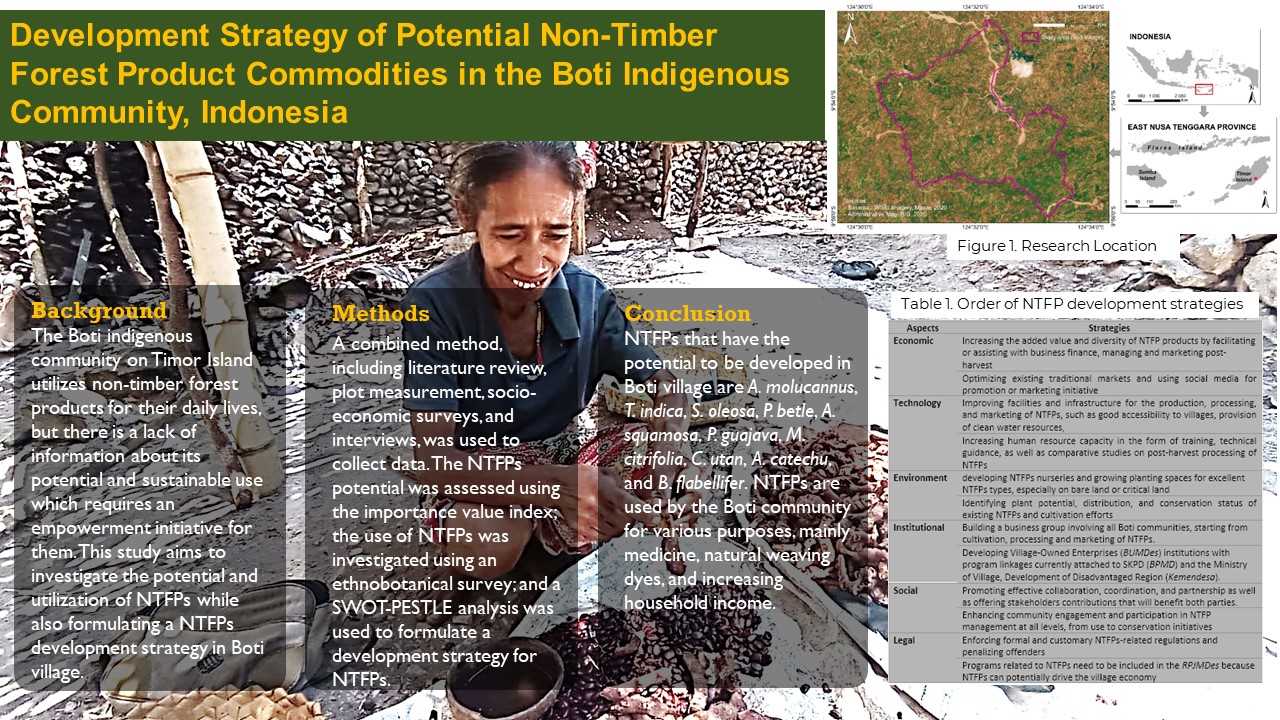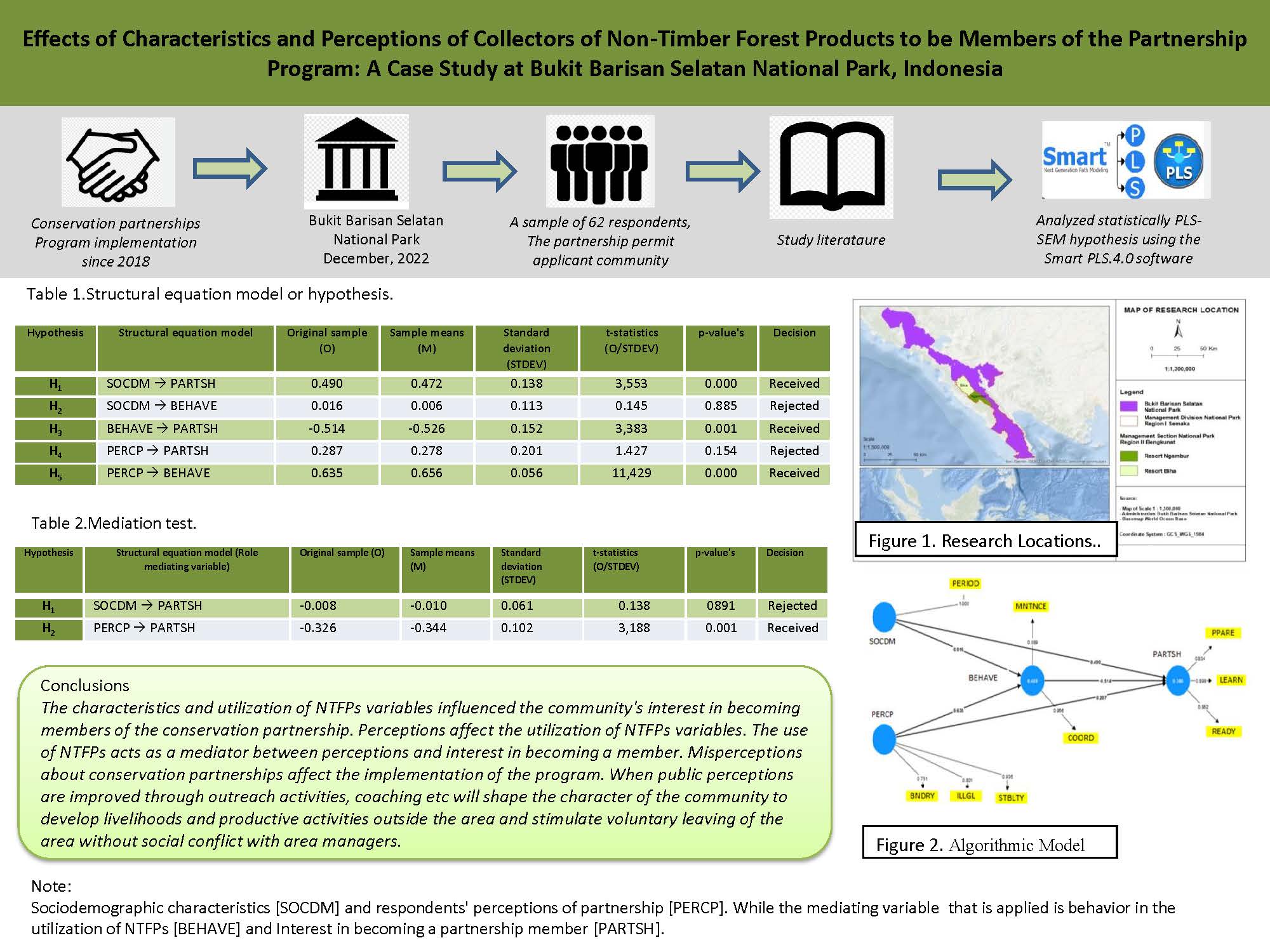Development Strategy of Potential Non-Timber Forest Product Commodities in the Boti Indigenous Community, Indonesia
Abstract
The Boti indigenous community on Timor Island utilizes non-timber forest products for their daily lives, but there is a lack of information about their potential and sustainable use, which requires an empowerment initiative for them. This study aims to investigate the potential and utilization of NTFPs while also formulating an NTFPs development strategy in Boti Village. A combined method, including literature review, plot measurement, socio-economic surveys, and interviews, was used to collect data. NTFPs were evaluated for their potential using the importance value index; their utilization was studied through an ethnobotanical survey; and an NTFP development strategy was formulated utilizing a SWOT-PESTLE analysis. The results show that three types—candlenut, tamarind, and lac tree—dominate among the 13 species of the NTFPs. NTFPs are used for various purposes, such as medicinal, natural dye weaving, and selling to raise household income. The NTFPs development in Boti village needs to be prioritized, with a focus on increasing the added value of NTFPs through funding, facilitation, technological assistance, planting and preserving, collaborating more, and enforcing formal and customary rules. The results can be used as a baseline or reference for sustainable NTFP management and the empowerment of the Boti indigenous community.
References
Andika, R. R. (2016). Ekologi dan etnobotani pohon penghasil damar pada suku Anak Dalam di Taman Nasional Bukit Duabelas. Bogor: Institut Pertanian Bogor.
Az-Zahra, F. R., Sari, N. L. W., Saputry, R., Nugroho, G. D., Pribadi, T., Sunarto, S., & Setyawan, A. D. (2021). Review: Traditional knowledge of the Dayak Tribes (Borneo) in the use of medicinal plants. Biodiversitas Journal of Biological Diversity, 22(10), 57. https://doi.org/10.13057/biodiv/d221057
Cabral, M. R. P., dos Santos, S. A. L., Stropa, J. M., da Silva, R. C. de L., Cardoso, C. A. L., de Oliveira, L. C. S., Scharf, D. R., Simionatto, E. L., Santiago, E. F., & Simionatto, E. (2016). Chemical composition and thermal properties of methyl and ethyl esters prepared from Aleurites moluccanus (L.) Willd (Euphorbiaceae) nut oil. Industrial Crops and Products, 85, 109–116. https://doi.org/10.1016/j.indcrop.2016.02.058
Candri, D. A., Hakimi, B., Ahyadi, H., Suana, I. W., Prasedya, E. S., Ambarwati, K., & Mardiati, A. U. (2023). Condition of coral diversity in Kuta Mandalika Coastal, Central Lombok Regency. Jurnal Biologi Tropis, 23(2), 15–26. https://doi.org/10.29303/jbt.v23i2.5627
Chamberlain, J., Small, C., & Baumflek, M. (2019). Sustainable forest management for nontimber products. Sustainability, 11(9), 2670. https://doi.org/10.3390/su11092670
Chen, Y., & Cao, Y. (2014). Response of tree regeneration and understory plant species diversity to stand density in mature Pinus tabulaeformis plantations in the hilly area of the Loess Plateau, China. Ecological Engineering, 73, 238–245. https://doi.org/10.1016/j.ecoleng.2014.09.055
CIFOR-ICRAF. (2016). Grand strategy pengelolaan HHBK unggulan yang terintegrasi berbasis bentang alam di Kab. TTS. Retrived from https://www.cifor.org/knowledge/slide/7861
Cunningham, A. B. (Ed.) (2001). Applied ethnobotany: People, wild plant use and conservation. London: Routledge. https://doi.org/10.4324/9781849776073
[DPR] Dewan Perwakilan Rakyat. (2018). Rancangan undang undang tentang masyarakat hukum adat. Retrieved from https://berkas.dpr.go.id/akd/dokumen/RJ2-20171106-094054-7086.pdf
Fagbemi, K. O., Aina, D. A., Adeoye-Isijola, M. O., Naidoo, K. K., Coopoosamy, R. M., & Olajuyigbe, O. O. (2022). Bioactive compounds, antibacterial and antioxidant activities of methanol extract of Tamarindus indica Linn. Scientific Reports, 12(1), 9432. https://doi.org/10.1038/s41598-022-13716-x
Fibri, D. L. N., Anjani, D. M., Maymunah, Putro, A. W., & Muhammad, D. R. A. (2022). Spice mapping profile in Indonesian traditional side dishes and beverages. Research Square. https://doi.org/10.21203/rs.3.rs-2048305/v1
Guariguata, M. R., García-Fernández, C., Sheil, D., Nasi, R., Herrero-Jáuregui, C., Cronkleton, P., & Ingram, V. (2010). Compatibility of timber and non-timber forest product management in natural tropical forests: Perspectives, challenges, and opportunities. Forest Ecology and Management, 259(3), 237–245. https://doi.org/10.1016/j.foreco.2009.11.013
Gusmailina, Saputra, N. A., & Sumadiwangsa, S. (2020). Management prospects through development of non-timber forest products. IOP Conference Series: Earth and Environmental Science, 591(1), 012042. https://doi.org/10.1088/1755-1315/591/1/012042
Harbi, J., Erbaugh, J. T., Sidiq, M., Haasler, B., & Nurrochmat, D. R. (2018). Making a bridge between livelihoods and forest conservation: Lessons from non timber forest products’ utilization in South Sumatera, Indonesia. Forest Policy and Economics, 94, 1–10. https://doi.org/10.1016/j.forpol.2018.05.011
Harbi, J., Erbaugh, J. T., Widagdo, F. R. A., Mauri, J., Supriyanto, S., & Milantara, N. (2020). Three generations of forest peoples’ empowerment in Indonesia: process towards sustainable and equitable forest management. Jurnal Manajemen Hutan Tropika, 26(2), 91–104. https://doi.org/10.7226/jtfm.26.2.91
Herningtyas, W., Pujiono, E., Kurniadi, R., & Setyowati, R. (2023). Disaster risk reduction through local knowledge and practices-A case study of the indigenous Boti Tribe, Timor Island, Indonesia. In G. K. Panda, U. Chatterjee, N. Bandyopadhyay, M. D. Setiawati, & D. Banerjee, D. (Eds.), Indigenous knowledge and disaster risk reduction. Disaster risk reduction (pp. 441–463). Springer, Cham. https://doi.org/10.1007/978-3-031-26143-5_19
Kanfon, R. E., Fandohan, A. B., Agbangnan, P. D. C., & Chadare, F. J. (2023). Ethnobotanical and nutritional value of pulps, leaves, seeds, and kernels of Tamarindus indica L.: A review. Agronomie Africaine, 35, 297–322.
Kasih, N. P. M. (2022). Pemanfaatan kunyit asam sebagai bahan dasar sorbet. Jurnal Ilmiah Pariwisata dan Bisnis, 1(7), 1848–1864. https://doi.org/10.22334/paris.v1i7.126
Kemendesa. (2023). Hasil rekomendasi IDM. Retrived from https://idm.kemendesa.go.id/rekomendasi
Kurniasih, H., Ford, R. M., Keenan, R. J., & King, B. (2021). The evolution of community forestry through the growth of interlinked community institutions in Java, Indonesia. World Development, 139, 105319. https://doi.org/10.1016/j.worlddev.2020.105319
Kusmana, C. (1997). Metoda survey vegetasi. Bogor: IPB Press.
Kusuma, Y. W. C., Rembold, K., Tjitrosoedirdjo, S. S., & Kreft, H. (2018). Tropical rainforest conversion and land use intensification reduce understorey plant phylogenetic diversity. Journal of Applied Ecology, 55(5), 2216–2226. https://doi.org/10.1111/1365-2664.13201
Mandang, I. C., Polii, B. J. V., & Walangitan, H. (2018). Strategi pengembangan hasil hutan bukan kayu di kawasan hutan lindung Gunung Soputan KPHP Unit V Provinsi Sulawesi Utara. AGRI-SOSIOEKONOMI, 14(3), 1. https://doi.org/10.35791/agrsosek.14.3.2018.21530
Muli, E., Sulistyorini, I. S., Poedjirahajoe, E., Faida, L. R. W., Purwanto, R. H., & Imanuddin, I. (2021). Structure and dominance of species in mangrove forest on Kutai National Park, East Kalimantan, Indonesia. Jurnal Manajemen Hutan Tropika, 27(1), 59–68. https://doi.org/10.7226/jtfm.27.1.59
Mulu, M., Ntelok, Z. R. E., Petrus S. I. I., & Mulu, H. (2020). Ethnobotanical knowledge and conservation practices of indigenous people of Mbeliling forest area, Indonesia. Biodiversitas Journal of Biological Diversity, 21(5), 12. https://doi.org/10.13057/biodiv/d210512
Muttaqin, M. Z., Ilham, I., & Idris, U. (2021). Sosialisasi pengelolaan hhbk bagi masyarakat di perbatasan Papua Indonesia-Papua New Guinea. Jurnal PkM Pengabdian Kepada Masyarakat, 4(3), 240. https://doi.org/10.30998/jurnalpkm.v4i3.6462
NTT Provincial Economic Bureau. (2022). Konsultasi publik fasilitasi pengembangan sentra HHBK unggulan jambu mete dalam rangka penyusunan Peraturan Gubernur tentang sentra pengembangan jambu mete di Kabupaten Flores Timur. https://biro-perekonomian-provntt.com/
Oktavia, D., Pratiwi, S. D., Munawaroh, S., Hikmat, A., & Hilwan, I. (2021). Floristic composition and species diversity in three habitat types of heath forest in Belitung Island, Indonesia. Biodiversitas Journal of Biological Diversity, 22(12), 40. https://doi.org/10.13057/biodiv/d221240
Parra-Lopez, C., Reina-Usuga L, C. C.-T., Sayadi, S., & Klerkx, L. (2021). Digital transformation of the agrifood system: Quantifying the conditioning factors to inform policy planning in the olive sector. Land Use Policy, 108. https://doi.org/10.1016/j.landusepol.2021.105537
Pasaribu, G., Winarni, I., Gusti, R. E. P., Maharani, R., Fernandes, A., Harianja, A. H., Saragih, G. S., Turjaman, M., Tampubolon, A. P., Kuspradini, H., Lukmandaru, G., Njurumana, G. N., Sukito, A., Aswandi, A., & Kholibrina, C. R. (2021). Current challenges and prospects of Indonesian non-timber forest products (NTFPs): A review. Forests, 12(12), 1743. https://doi.org/10.3390/f12121743
Puhlick, J. J., Laughlin, D. C., & Moore, M. M. (2012). Factors influencing ponderosa pine regeneration in the southwestern USA. Forest Ecology and Management, 264, 10–19. https://doi.org/10.1016/j.foreco.2011.10.002
Rahman, M. H., Roy, B., & Islam, M. S. (2021). Contribution of non-timber forest products to the livelihoods of the forest-dependent communities around the Khadimnagar National Park in northeastern Bangladesh. Regional Sustainability, 2(3), 280–295. https://doi.org/10.1016/j.regsus.2021.11.001
Reihanian, A., Mahmood, N. Z. B., Kahrom, E., & Hin, T. W. (2012). Sustainable tourism development strategy by SWOT analysis: Boujagh National Park, Iran. Tourism Management Perspectives, 4, 223–228. https://doi.org/10.1016/j.tmp.2012.08.005
Shaah, M. A., Allafi, F., Hossain, M. S., Alsaedi, A., Ismail, N., Kadir, M. O. A., & Ahmad, M. I. (2021). Candlenut oil: Review on oil properties and future liquid biofuel prospects. International Journal of Energy Research, 45(12), 17057–17079. https://doi.org/10.1002/er.6446
Silalahi, M. (2020). Morinda citrifolia: Bioactivity and utilization as traditional medicine and food for the community. International Journal of Business, Economics, and Social Development, 1(2), 81–89. https://doi.org/10.46336/ijbesd.v1i2.40
Subroto, E., Widjojokusumo, E., Veriansyah, B., & Tjandrawinata, R. R. (2017). Supercritical CO2 extraction of candlenut oil: process optimization using Taguchi orthogonal array and physicochemical properties of the oil. Journal of Food Science and Technology, 54(5), 1286–1292. https://doi.org/10.1007/s13197-017-2542-7
Suchiang, B. R., Nonghuloo, I. M., Kharbhih, S., Singh, P. P., Tiwary, R., Adhikari, D., Upadhaya, K., Ramanujam, P., & Barik, S. K. (2020). Tree diversity and community composition in sacred forests are superior than the other community forests in a human-dominated landscape of Meghalaya. Tropical Ecology, 61(1), 84–105. https://doi.org/10.1007/s42965-020-00066-w
Sumanto, S. E., & Takandjandji, M. (2016). Identifikasi pemanfaatan hasil hutan oleh masyarakat: Upaya konservasi sumber daya genetik dan sosial budaya. Buletin Plasma Nutfah, 20(1), 27. https://doi.org/10.21082/blpn.v20n1.2014.p27-40
Tamene, S., Negash, M., Makonda, F. B., Chiwona-Karltun, L., & Kibret, K. S. (2023). Ethnobotanical study on medicinal plant knowledge among three ethnic groups in peri-urban areas of south-central Ethiopia. Journal of Ethnobiology and Ethnomedicine, 19(1), 55. https://doi.org/10.1186/s13002-023-00629-w
Uztürk, D., & Büyüközkan, G. (2023). Strategic analysis for advancing smart agriculture with the analytic SWOT/PESTLE framework: A case for Turkey. Agriculture, 13(12), 2275. https://doi.org/10.3390/agriculture13122275
Variyana, Y., Ermayaa, D., Shintawati, Cendekiaa, D., & Mahfud, M. (2023). Response surface methodology-based parameter optimization of candlenut seeds (Aleurites moluccana Willd) extraction. Equilibrium Journal of Chemical Engineering, 7(1), 69–77. https://doi.org/https://dx.doi.org/10.20961/equilibrium.v7i1.72842
Wang, R., Hu, R., Wu, Y., Shaaban, M., Zhang, T., Pan, G., Lu, J., & Jiang, Y. (2024). Elevation-dependent natural regeneration of Abies georgei var. smithii forest in Southeastern Tibet. Forests, 15(1), 142. https://doi.org/10.3390/f15010142
Wibowo, G. D. H. (2017). Analisis kebijakan pengelolaan hasil hutan bukan kayu (HHBK) di NTB dan NTT. Jurnal Hukum & Pembangunan, 43(2), 180. https://doi.org/10.21143/jhp.vol43.no2.1484
Wijana, N. (2014). Analisis komposisi dan keanekaragaman spesies tumbuhan di hutan Desa Bali Aga Tigawasa, Buleleng, Bali. Jurnal Sains dan Teknologi, 3(1). https://doi.org/10.23887/jst-undiksha.v3i1.2907
Yang, X., Yan, D., & Liu, C. (2014). Natural regeneration of trees in three types of afforested stands in the Taihang Mountains, China. PLoS ONE, 9(9), e108744. https://doi.org/10.1371/journal.pone.0108744
Authors

This work is licensed under a Creative Commons Attribution 4.0 International License.
Jurnal Manajemen Hutan Tropika is an open access journal which means that all contents is freely available without charge to the user or his/her institution. Users are allowed to read, download, copy, distribute, print, search, or link to the full texts of the articles in this journal without asking prior permission from the publisher or the author. This is in accordance with the Budapest Open Access Initiative (BOAI) definition of open access.






